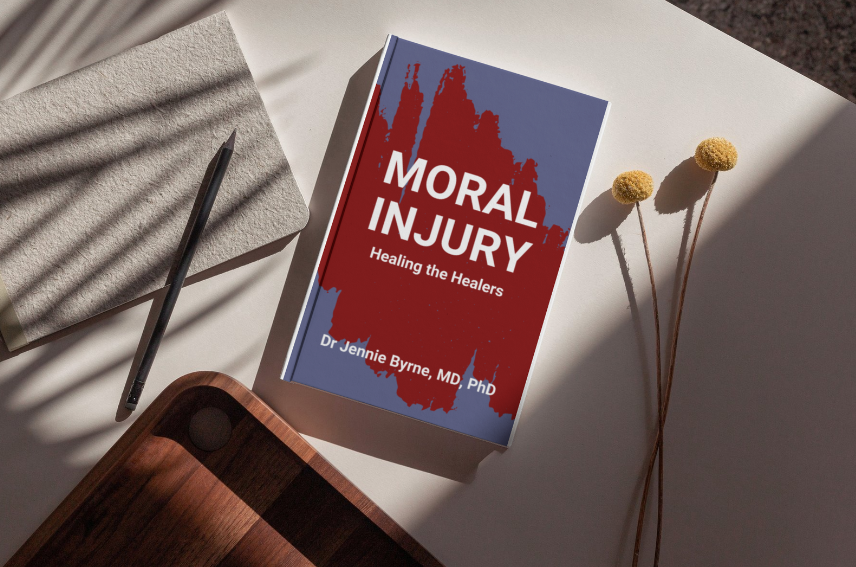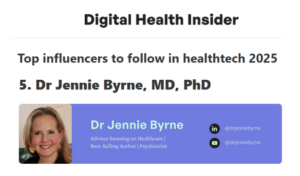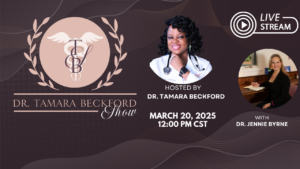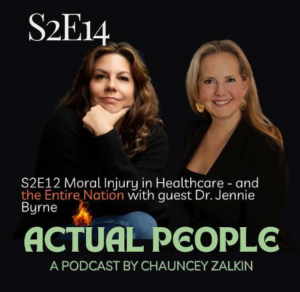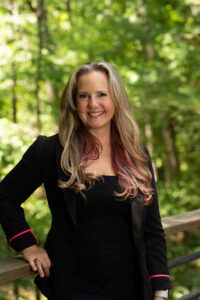What happens when those who dedicate their lives to healing others find themselves wounded by the very system they serve? In Moral Injury: Healing the Healers, Dr. Jennie Byrne, MD, PhD, offers a compassionate exploration into the emotional and ethical tolls faced by healthcare professionals, shedding light on the often-overlooked phenomenon of moral injury.
What is the Book About?
Moral Injury: Healing the Healers delves into the profound psychological and emotional challenges that healthcare professionals encounter when systemic constraints prevent them from acting in accordance with their moral and ethical beliefs. Dr. Byrne, a seasoned psychiatrist, combines personal anecdotes, case studies, and evidence-based research to illuminate how these moral conflicts can lead to feelings of guilt, shame, and disillusionment among clinicians. The book emphasizes that these experiences are not merely instances of burnout but are deeper wounds that require acknowledgment and healing.
Through a holistic approach, Dr. Byrne provides actionable strategies for recognizing and addressing moral injury. She advocates for creating safe spaces where healthcare workers can share their experiences, fostering a culture of empathy and support within medical institutions. By challenging outdated models and emphasizing the importance of human connection, the book lays the groundwork for transformative change in the healthcare system.
Book Details
Print length: 182 pages
Language: English
Publication date: May 8, 2024
Genre: Healthcare, Psychology, Professional Development
Book Author
Core Theme
At the heart of Moral Injury: Healing the Healers is the exploration of how systemic issues within healthcare can lead to moral injury among professionals. Dr. Byrne argues that when clinicians are unable to provide the care they deem ethically appropriate due to institutional constraints, they suffer deep psychological wounds. This moral injury is distinct from burnout, as it stems from a violation of one’s core values rather than mere exhaustion.
The book emphasizes the need for systemic change, advocating for healthcare environments that prioritize ethical integrity and human connection. Dr. Byrne calls for a shift from viewing healthcare workers as expendable resources to recognizing them as individuals whose moral and emotional well-being is crucial to the efficacy of the healthcare system.
Main Lessons
A few impactful summary lessons from Moral Injury:
1. Reframing Burnout as Systemic Moral Injury
Burnout has long been viewed as a personal failing or a byproduct of poor resilience, but this book powerfully shifts the narrative by showing how moral injury is often the deeper, more insidious wound. Unlike burnout, which suggests individual weakness or fatigue, moral injury arises when healthcare professionals are unable to provide the level of care they believe is ethically necessary due to system limitations. It stems from the disconnection between a clinician’s values and the realities of a flawed healthcare infrastructure, creating emotional and moral dissonance that cannot be fixed through self-care alone. By naming the problem accurately, Dr. Byrne allows for more precise healing and drives the reader to question how systems—not just people—must change.
2. Healing Begins with Recognizing Invisible Wounds
One of the book’s most enlightening contributions is the validation it offers to healthcare professionals who feel something is wrong but haven’t had the language to describe it. Naming moral injury gives clarity to what has been an ambiguous pain, buried under years of silence and mislabeling. It brings visibility to experiences of betrayal, helplessness, and systemic obstruction that many endure in their roles but rarely vocalize. For countless readers, this recognition is the first step toward healing because it acknowledges that their suffering is not imagined, exaggerated, or solely their responsibility—it’s real, complex, and deeply systemic.
3. Challenging Cultural Norms in Communication
Dr. Byrne encourages rethinking even small, habitual practices, like how clinicians communicate with patients. She offers a bold example of embracing emojis in professional healthcare settings—not as a gimmick, but as a tool to convey emotional nuance and efficiency. While it may seem unconventional, such a suggestion pushes the boundaries of rigid formality in medicine, opening up possibilities for more authentic and human-centered connections. This simple yet radical shift exemplifies how even minor adaptations can promote empathy and clarity in interactions that are too often stripped of warmth.
4. Empathy and Human Connection Must Lead System Change
At the core of Byrne’s message is a call to prioritize humanism in healthcare—not as a soft skill, but as a foundational principle for reform. Her stories and research show that emotional disconnection is not just personally damaging for clinicians; it undermines the very purpose of healthcare. When professionals feel like replaceable cogs in a machine, the system loses its soul. Restoring that soul requires intentional shifts in leadership, language, and culture that honor the emotional lives of those providing care. The lesson is clear: systems built without empathy cannot deliver true healing.
5. Vulnerability is a Path to Strength and Change
Through her candid storytelling, Dr. Byrne shows that vulnerability is not a liability—it is a source of truth and transformation. She shares her own professional challenges, including powerlessness in hierarchical environments and the emotional cost of remaining silent. These personal reflections resonate with readers who may carry similar burdens but feel alone in them. Her courage to share becomes a model, encouraging others to own their stories, speak up, and act as catalysts for change. The message is profound: by embracing our pain honestly, we become more equipped to evolve individually and collectively.
6. The Term Burnout Blames the Individual
Byrne dismantles the popular use of the term “burnout” by highlighting how it subtly places blame on the individual rather than addressing the structural realities creating distress. Referring to burnout as an “industrial term,” she reveals how it reinforces a mechanized view of healthcare where both patients and providers are reduced to parts in a system. This insight flips the lens: what’s needed is not more resilience training but systemic accountability. Recognizing this distinction changes the conversation entirely, urging healthcare institutions to move beyond lip service and take responsibility for moral erosion.
7. Moral Injury Impacts All, Not Just Providers
Although the book centers on healthcare professionals, its implications ripple far beyond the clinical sphere. As readers outside the profession have noted, it opens their eyes to the human side of doctors—the emotional labor, the ethical conflicts, the quiet suffering behind the white coat. This expanded awareness challenges patients and society to hold more compassionate expectations and advocate for a more sustainable, dignified system. The moral injury of providers ultimately affects the quality of care for everyone, making it a shared societal issue rather than an isolated professional crisis.
8. Practical Tools are Just as Important as Insight
While the book provides deep emotional and intellectual understanding, it doesn’t stop there. Dr. Byrne also equips readers with actionable tools and strategies to address moral injury in their lives and organizations. From reflective exercises to communication shifts and team interventions, the book moves theory into practice. This blend of insight and implementation ensures that the work doesn’t remain abstract but becomes part of real change. Readers leave not just with understanding, but with a map for action—one that feels doable even in a deeply flawed system.
9. Stories Create Bridges Toward Collective Healing
One of the most resonant elements of the book is how Dr. Byrne weaves together scientific research with deeply human stories, including her own. These narratives don’t just illustrate concepts—they help readers feel seen, heard, and understood. Whether it’s a provider navigating impossible choices or a patient reflecting on their care, the storytelling grounds the book in emotional reality. By building these bridges, Byrne fosters a sense of collective healing, where shared pain can lead to shared solutions and solidarity across roles.
10. Transforming Healthcare Requires Naming the Truth
Above all, this book teaches that healing is not possible until the truth is named—truth about the systems that hurt people, the language that obscures harm, and the silence that enables suffering. Dr. Byrne’s insistence on calling out moral injury is more than semantics; it’s an act of defiance and a commitment to change. Naming things clearly allows providers to stop internalizing blame and instead begin the courageous work of transformation. It’s a lesson in integrity: only when we name what’s broken can we begin to rebuild what matters.
Key Takeaways
Key summary takeaways from the book:
- Moral injury arises when healthcare professionals are prevented from acting in line with their ethical beliefs.
- Distinguishing moral injury from burnout is essential for effective intervention and support.
- Creating safe spaces for open dialogue can facilitate healing among clinicians.
- Systemic reforms are necessary to address the root causes of moral injury in healthcare.
- Empathy and human connection are vital components of a resilient healthcare system.
Book Strengths
Moral Injury: Healing the Healers stands out for its empathetic approach and practical guidance. Dr. Byrne’s integration of personal narratives with scholarly research provides a comprehensive understanding of moral injury. The book’s emphasis on actionable strategies empowers healthcare professionals to recognize and address their own moral injuries, fostering a path toward healing and systemic change.
Who This Book Is For
This book is an essential read for healthcare professionals across all disciplines who have grappled with ethical dilemmas and systemic constraints. It also serves as a valuable resource for healthcare administrators, policymakers, and educators seeking to understand and mitigate the factors contributing to moral injury within the medical field.
Why Should You Read This Book?
Reading Moral Injury: Healing the Healers offers a profound insight into the emotional and ethical challenges faced by healthcare workers. Dr. Byrne’s compassionate narrative not only validates the experiences of clinicians but also provides a roadmap for healing and systemic reform. For anyone invested in the well-being of healthcare professionals and the improvement of the healthcare system, this book is both enlightening and indispensable.
Concluding Thoughts.
Moral Injury: Healing the Healers is more than a book; it’s a call to action for a more compassionate and ethically grounded healthcare system. Dr. Byrne’s exploration of moral injury sheds light on the silent struggles of clinicians, urging a collective effort to acknowledge and address these deep-seated issues.
By combining personal narratives with practical solutions, the book serves as a guide for both individual healing and systemic transformation. It challenges readers to rethink the structures of healthcare and to prioritize the moral and emotional well-being of those who dedicate their lives to healing others.
→ Get the book on Amazon or discover more via the author’s website or her LinkedIn.
* The publisher and editor of this summary review made every effort to maintain information accuracy, including any published quotes, lessons, takeaways, or summary notes.

